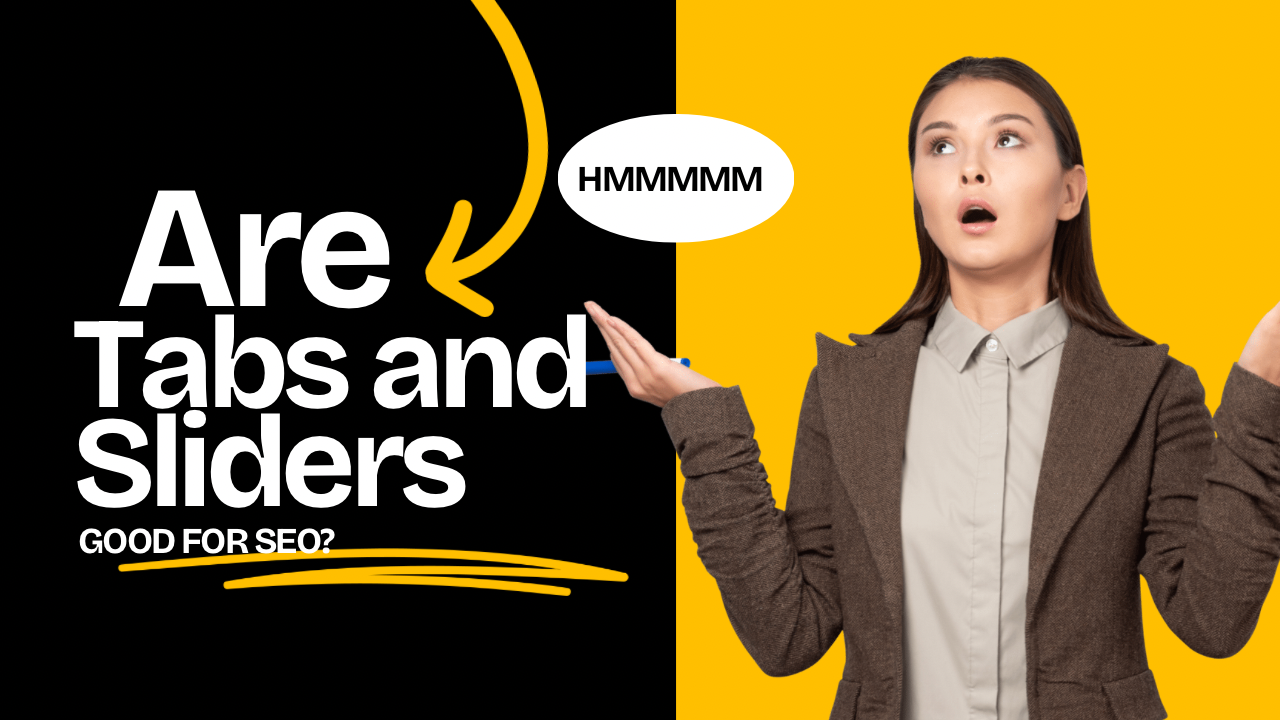Are Tabs and Sliders Good for SEO and User Experience? Here’s What You Need to Know
As websites grow more content-heavy and visually complex, designers often turn to interactive web elements like tabs, accordions, and sliders to keep things clean and organized.
These tools help segment information in a user-friendly way, but they raise an important question for Content Optimization and Search Engine Optimization :
Are content-hiding elements good or bad for SEO and user experience (UX)?
Let’s take a deep dive into the pros and cons, and more importantly, what Google really says about these elements.
The Appeal of Tabs and Sliders
Tabs and sliders are incredibly popular for good reason. They offer several user-focused benefits:
Better Visual Organization
One of the main appeals of using tabs or accordions is visual simplicity.
Rather than overwhelming the user with a long scroll of text or information, these elements let you group related content under toggleable sections.
This is especially effective for FAQs, pricing comparisons, product specifications, and feature breakdowns.
Enhanced Mobile Experience
Mobile users benefit even more from compact layouts.
Tabs and sliders help reduce the need for excessive scrolling, providing a streamlined experience that aligns well with mobile-first design principles.
Encouraged Exploration
When done right, interactive content elements can boost engagement.
Users are more likely to interact with tabs and sliders if they’re intuitive, revealing additional content that keeps them on the page longer and potentially leading to conversions.
But What About the Drawbacks?
Despite their advantages, content-hiding elements come with significant caveats—especially when it comes to SEO and accessibility.
Risk to SEO Visibility
Google’s crawlers are generally able to read content that is in the page’s initial HTML/DOM at load time—even if that content is hidden via CSS or JavaScript.
However, Google has also hinted that content hidden behind tabs or sliders may be given less weight when ranking pages.
That means if your most important keywords or primary product information are buried inside a non-visible tab, it may not be treated with the same priority as always-visible content.
This could reduce your chances of ranking for high-value search terms.
User Experience Issues
Not all users will click through every tab or slider—some might not even realize the content is interactive.
This creates a risk that essential information will go unnoticed.
In worst-case scenarios, tabs that are poorly implemented can create accessibility barriers for screen readers or keyboard navigation, alienating a segment of your audience.
Load and Crawl Issues
Another technical concern: if your hidden content is only loaded dynamically after a user interacts with the tab (i.e., it doesn’t exist in the HTML until a user clicks), it may not be indexed at all by search engines.
This is especially true for JavaScript-heavy implementations that aren’t using progressive enhancement or server-side rendering.
Google’s Official Position
Google has addressed the use of hidden content in several public discussions. The general stance is:
- Content that is in the initial page load and the DOM is indexable—even if it’s not immediately visible to users.
- However, Google may assign less importance to content that’s hidden, especially if it appears less prominent or is loaded only on interaction.
In a 2020 Google blog post, the team confirmed that hidden content can still be indexed, but context matters.
Google’s John Mueller has also noted that “if something is important, it should be visible by default.”
This doesn’t mean you should never use tabs.
Instead, it’s a prompt to prioritize key content and avoid hiding critical value propositions, keywords, or conversion elements.
Best Practices for Using Tabs and Sliders
If you’re going to use content-hiding elements—and they can definitely be beneficial—follow these best practices to maintain both SEO value and a great user experience:
Show the Most Important Info First
Your core message, unique selling points, and top keywords should live in always-visible areas of the page.
Use tabs and accordions for supplementary information such as technical details, extended specs, or secondary FAQs.
Load All Content in the Initial DOM
Make sure the full tab or slider content is present in the initial page load, even if it’s hidden via CSS. This ensures that search engines can crawl it effectively.
Use Semantic HTML and ARIA Attributes
These help assistive technologies understand the structure and function of interactive elements.
Accessible design is not only good for users—it also signals quality to Google.
Test with Google Tools
Use tools like Google’s URL Inspection Tool in Search Console or the Mobile-Friendly Test to see how your content is rendered and indexed.
Check if hidden content appears in the rendered HTML.
Balance Interaction and Usability
Don’t overuse tabs or sliders. When everything is hidden behind clicks, you risk frustrating your audience.
Stick to a few well-labeled sections and ensure users always know how to access more content.
When to Avoid Tabs and Sliders Altogether
There are scenarios where it’s better to avoid hiding content:
- For landing pages focused on SEO, where keyword density, clarity, and content scannability are critical.
- On product pages, where important buying information needs to be front and center.
- When dealing with accessibility-sensitive audiences, where full visibility enhances user trust and navigation.
Final Thoughts
Tabs and sliders can be incredibly useful tools for content organization and user engagement—but they’re not without risk.
From an SEO standpoint, you must ensure any hidden content is accessible to crawlers and not holding back your keyword visibility.
The golden rule: if it’s important for your audience and your rankings, make it visible.
Use tabs to enhance clarity—not to bury information. With thoughtful design and SEO-aware implementation, you can enjoy the best of both worlds.



